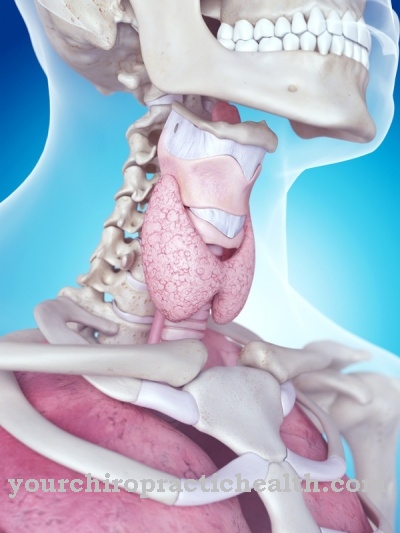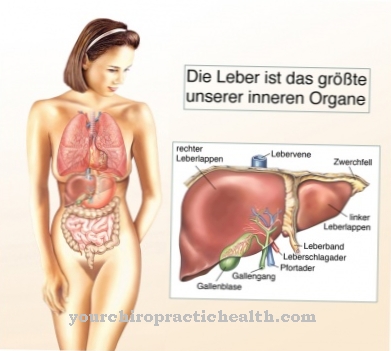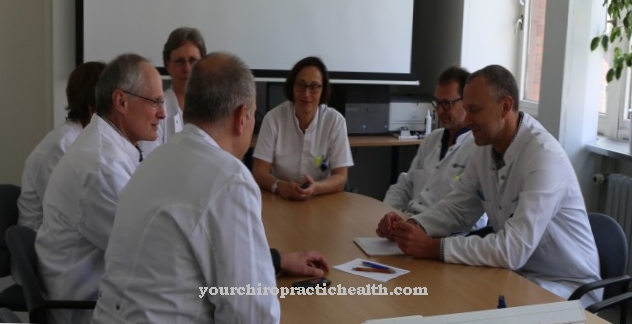A distinction is made between the "classic" Iontophoresis for the intensive introduction of active ingredients from ointments via electrodes into the body and the Tap water iontophoresis, in which weak direct current flows through the body using electrodes that are submerged in water.
This conservative treatment method is successfully used in dermatology for the treatment of various forms of hyperhidrosis.
What is iontophoresis?
Iontophoresis is a medical procedure relating to the absorption of medicinal substances through the skin by means of an electrical direct current.
Years of experience have shown that the efficiency of the active ingredients can be increased in this way. About 40% of the sick people suffer from this form.The concentration of many In tap water iontophoresis, one or two containers are filled with water and the electrodes, which are connected to a control unit, are immersed in them. A weak direct current flows through the body via the hands or feet in the water.
Function, effect & goals
The areas of application are divided into five areas that can be affected symptomatically. A distinction must also be made between conventional iontophoresis and tap water iontophoresis.
- Facial hyperhidrosis
Because excessive sweating, which occurs particularly in the T-zone on the face (chin, mouth, nose and forehead), cannot be hidden, those affected suffer particularly badly from psychological stress.
- Axillary hyperhidrosis
About 40% of the sick people suffer from this form. The concentration of many sweat glands in a cavity (armpit) can hardly evaporate at all, which leads to unpleasant and telltale sweat marks with an often intense sweat odor on outerwear.
- Hyperhidrosis palmaris
Not only the palms are affected. Rather, the increased sweating also occurs on the fingers and the ball of the hand so strongly that the skin is clammy and moist. In extreme cases, they are discolored dark blue-red and feel spongy. The psychological problem can be compared to that of a hyperhidrosis facialis. The danger of social exclusion should not be underestimated. Young people in the social phase should be treated immediately so that no behavioral disorders occur.
- Plantar hyperhidrosis
These symptoms have nothing to do with "sweaty or cheesy feet" in general. Rather, it is an excessive and constant sweating regardless of physical exertion or outside temperature. The soles of the feet are often soggy, which among other things noticeable on a whitish cornea. Allergies as well as athlete's foot and plantar warts as well as nail bed inflammation occur with a penetrating odor.
- Hyperhidrosis generalis
This cannot be treated entirely with iontophoresis. However, the (multiple) partial treatment can bring about an increase in the quality of life. For example, when the immediately visible areas of the face, armpits and hands are being treated. Any form of hyperhidrosis is aggravated by the psychological stress that those affected often suffer.
Iontophoresis, also carried out with tap water, is used with great success worldwide for hyperhidrosis (profuse sweating). The positive results of this direct current therapy convince resident dermatologists and clinicians alike. In the practice, however, it can also be carried out at home after instruction. The time expenditure of approx. 10 minutes per day is minimal, the application is simple and the total costs (one-time purchase and low operating costs) are low. There is also a high level of efficiency. The effect starts after just 10 uses. With extremely heavy sweating, the chance of success with the right device is around 98%.
Iontophoresis devices are available for:
- sweating of hands and feet
- against armpit sweat
- against sweating in the face
A special face mask with graphite fibers is offered against sweating in the T-zone.
The iontophoresis, too Stimulation current therapy called, is one of the therapeutic procedures in dermatology in which a weak electrical direct current acts on the skin. The absorption of active ingredients in the form of ointments is improved. The weak currents of the direct current generate almost no side effects. In addition, no drugs or surgery are required to treat hyperhidrosis. And yet the effect in its efficiency is convincing again and again in specialist circles.
In tap water iontophoresis as a one- or two-cell bath with galvanic current, also known as electrogalvanic bath, hands or feet are immersed in tubs filled with normal tap water. The plate electrodes attached to the edge of the bath conduct the weak current (galvanic current), which can be regulated via a power supply unit, into the water. It should be known that the current only flows in one direction. From one electrode to the other. Thanks to certain physical / chemical processes, biochemical cell actions occur in those affected. The galvanic current causes desensitization and at the same time has a harmonizing effect on the severely irritated sweat glands. The therapy should be accompanied medically.
You can find your medication here
➔ Drugs against sweating and sweatingRisks, side effects & dangers
In general, iontophoresis, like tap water iontophoresis, is considered safe and highly efficient. However, there are some contraindications. Anyone who has a pacemaker, cardiodefibrillator or metal implants implanted in their arms or legs cannot perform iontophoresis.
This therapy is also not suitable for women with an intrauterine pessary. Pregnancy also speaks against this treatment. Large skin defects or wounds as well as polyneuropathy, epilepsy and cardiac arrhythmias do not allow iontophoresis treatment any more than severe local inflammations and thromboses (blood clots). Acute circulatory disorders, a damaged lymphatic system and dementia are also contraindicated. If there are malignant diseases in the area of application, iontophoresis treatment must be avoided. If there is an acute fever, iontophoresis must be temporarily suspended. Children under six are exempt from treatment.



.jpg)









.jpg)

.jpg)
.jpg)











.jpg)